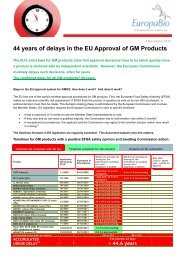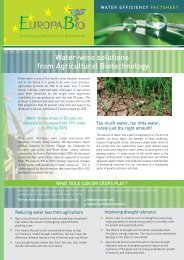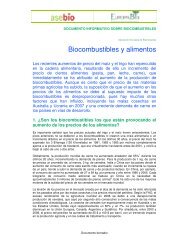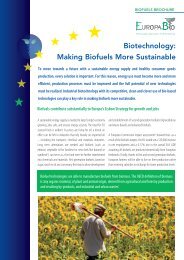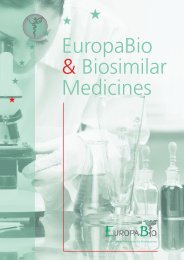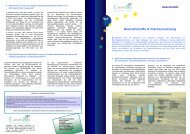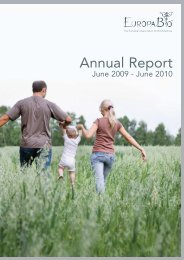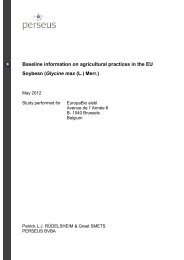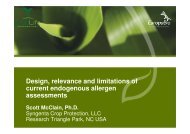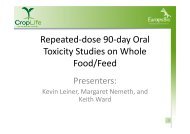GM crops: Reaping the benefits, but not in Europe - Europabio
GM crops: Reaping the benefits, but not in Europe - Europabio
GM crops: Reaping the benefits, but not in Europe - Europabio
Create successful ePaper yourself
Turn your PDF publications into a flip-book with our unique Google optimized e-Paper software.
14<br />
Reduced Insecticide Use<br />
Ano<strong>the</strong>r of <strong>the</strong> benchmarks of <strong>the</strong> foregone environmental <strong>benefits</strong> is <strong>in</strong>secticide use. In 2007 France<br />
saved an estimated 8,800 litres of <strong>in</strong>secticides due to 22,000 ha of Bt maize 38 . <strong>Europe</strong> could save<br />
between 410 and 700 tons of <strong>in</strong>secticides if Bt maize were used to its full potential. The potential<br />
annual direct farm <strong>in</strong>come benefit of Bt maize <strong>in</strong> <strong>the</strong> EU is estimated at between ¤160 million and<br />
¤247 million 39 .<br />
Romania’s Soy Story<br />
Before its accession to <strong>the</strong> EU <strong>in</strong> 2007, Romania ga<strong>in</strong>ed extensive experience with <strong>the</strong> cultivation of<br />
herbicide tolerant (HT) <strong>GM</strong> soya beans. These were grown commercially <strong>in</strong> Romania from 1999-2006<br />
and accounted for 68% (about 137,000 ha) of all soya beans planted <strong>the</strong>re <strong>in</strong> 2006. Cultivation <strong>the</strong>n<br />
had to be stopped because <strong>the</strong> crop had <strong>not</strong> yet been approved for cultivation by <strong>the</strong> EU. Romania is<br />
still wait<strong>in</strong>g for <strong>the</strong> authorisation of this <strong>GM</strong> soya bean which has been undergo<strong>in</strong>g EFSA assessment<br />
s<strong>in</strong>ce 2005.<br />
Farmers who used HT <strong>GM</strong> soya beans <strong>in</strong>dicated that it was <strong>the</strong> most profitable arable crop grown<br />
<strong>in</strong> Romania, with ga<strong>in</strong>s derived from higher yields and improved quality of seed coupled with lower<br />
costs of production. In 2006, <strong>the</strong> profit marg<strong>in</strong> per hectare ranked between ¤100 and ¤187, while <strong>in</strong><br />
<strong>the</strong> same year conventional soya bean growers were runn<strong>in</strong>g losses. The <strong>in</strong>crease <strong>in</strong> <strong>in</strong>come was <strong>the</strong><br />
result of herbicide cost reduction (on average, 1.9 treatments applied to HT soya beans versus 4.3<br />
treatments to <strong>the</strong> conventional one) as well as <strong>the</strong> higher yields (3-3.5t/ha for HT versus 2 t/ha for<br />
<strong>the</strong> conventional product) 40 . In Romania, <strong>the</strong> average size of farms adopt<strong>in</strong>g <strong>GM</strong> HT soya beans was<br />
between 30 and 40 ha.<br />
Accord<strong>in</strong>g to <strong>the</strong> Romanian agriculture m<strong>in</strong>ister Tabara, Romania’s annual loss from <strong>not</strong> cultivat<strong>in</strong>g<br />
<strong>GM</strong> soya beans amounted to approximately ¤1 billion 41 .<br />
FAST FACTS<br />
<strong>GM</strong> Soy <strong>in</strong> Romania 42<br />
- 31% higher yields (average)<br />
- $175/ha average net <strong>in</strong>crease <strong>in</strong> marg<strong>in</strong> (over 8 years commercial use)<br />
- $28.6 million annual extra farm <strong>in</strong>come (2006)<br />
- $92.7 million total extra farm <strong>in</strong>come 1999-2006



